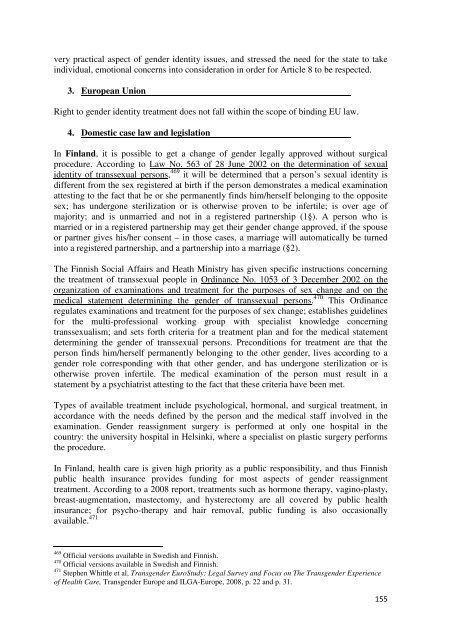Johanna Westeson - The ICHRP
Johanna Westeson - The ICHRP
Johanna Westeson - The ICHRP
Create successful ePaper yourself
Turn your PDF publications into a flip-book with our unique Google optimized e-Paper software.
very practical aspect of gender identity issues, and stressed the need for the state to take<br />
individual, emotional concerns into consideration in order for Article 8 to be respected.<br />
3. European Union<br />
Right to gender identity treatment does not fall within the scope of binding EU law.<br />
4. Domestic case law and legislation<br />
In Finland, it is possible to get a change of gender legally approved without surgical<br />
procedure. According to Law No. 563 of 28 June 2002 on the determination of sexual<br />
identity of transsexual persons, 469 it will be determined that a person’s sexual identity is<br />
different from the sex registered at birth if the person demonstrates a medical examination<br />
attesting to the fact that he or she permanently finds him/herself belonging to the opposite<br />
sex; has undergone sterilization or is otherwise proven to be infertile; is over age of<br />
majority; and is unmarried and not in a registered partnership (1§). A person who is<br />
married or in a registered partnership may get their gender change approved, if the spouse<br />
or partner gives his/her consent – in those cases, a marriage will automatically be turned<br />
into a registered partnership, and a partnership into a marriage (§2).<br />
<strong>The</strong> Finnish Social Affairs and Heath Ministry has given specific instructions concerning<br />
the treatment of transsexual people in Ordinance No. 1053 of 3 December 2002 on the<br />
organization of examinations and treatment for the purposes of sex change and on the<br />
medical statement determining the gender of transsexual persons. 470 This Ordinance<br />
regulates examinations and treatment for the purposes of sex change; establishes guidelines<br />
for the multi-professional working group with specialist knowledge concerning<br />
transsexualism; and sets forth criteria for a treatment plan and for the medical statement<br />
determining the gender of transsexual persons. Preconditions for treatment are that the<br />
person finds him/herself permanently belonging to the other gender, lives according to a<br />
gender role corresponding with that other gender, and has undergone sterilization or is<br />
otherwise proven infertile. <strong>The</strong> medical examination of the person must result in a<br />
statement by a psychiatrist attesting to the fact that these criteria have been met.<br />
Types of available treatment include psychological, hormonal, and surgical treatment, in<br />
accordance with the needs defined by the person and the medical staff involved in the<br />
examination. Gender reassignment surgery is performed at only one hospital in the<br />
country: the university hospital in Helsinki, where a specialist on plastic surgery performs<br />
the procedure.<br />
In Finland, health care is given high priority as a public responsibility, and thus Finnish<br />
public health insurance provides funding for most aspects of gender reassignment<br />
treatment. According to a 2008 report, treatments such as hormone therapy, vagino-plasty,<br />
breast-augmentation, mastectomy, and hysterectomy are all covered by public health<br />
insurance; for psycho-therapy and hair removal, public funding is also occasionally<br />
available. 471<br />
469 Official versions available in Swedish and Finnish.<br />
470 Official versions available in Swedish and Finnish.<br />
471 Stephen Whittle et al, Transgender EuroStudy: Legal Survey and Focus on <strong>The</strong> Transgender Experience<br />
of Health Care, Transgender Europe and ILGA-Europe, 2008, p. 22 and p. 31.<br />
155
















